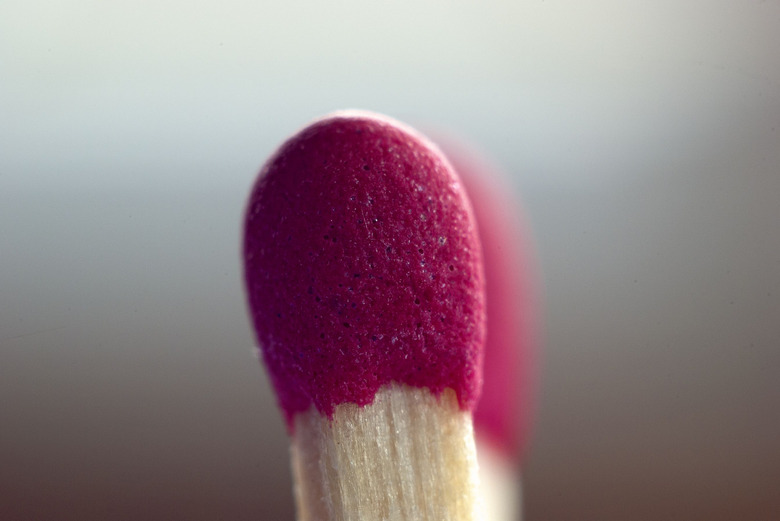What Is A Match Head Made Of?
Matches have been around for a surprisingly long time. The first sulfur-based matches appeared in the 1200s, and a way to strike them using phosphorous-soaked paper was devised in the 1600s. Modern matches date to 1827, when English chemist John Walker combined chemicals that would ignite when the match was drawn on sandpaper. His matches contained antimony trisulfide, but soon after, this was replaced by phosphorous sulfide. Today, you have your choice of regular or safety matches. They both take advantage of the reactivity of phosphorous compounds, but safety matches have to be drawn on a special surface to ignite.
TL;DR (Too Long; Didn't Read)
Phosphorous sulfide is the chemical compound that ignites match heads. It's found in the heads of strike-anywhere matches and in the strip on the side of safety match boxes. Other ingredients of match heads include potassium chlorate, phosphorous sesquisulfide, sulfur, glass powder, binders and fillers.
The Role of Phosphorous
The Role of Phosphorous
The 15th element in the periodic table, phosphorous is one of the most important elements in the human body. It's so reactive, though, that it never exists in its free form. White phosphorous, one of the three allotropes – or forms – of phosphorous, is so reactive that is has to be stored underwater, or it will burst into flames.
Phosphorous sulfide (P4S3) was substituted in 1831 for the antimony sulfide that was common in matches at that time. The resulting matches ignited well, but they gave off fumes that were so poisonous that the use of white phosphorous in matches was eventually outlawed. A few years later, the discovery of red phosphorous, an allotrope that isn't poisonous, made match use much safer.
Modern strike-anywhere match heads usually contain phosphorous sulfide produced only with red phosphorous. The heads of safety matches don't contain this chemical, but the abrasive strip on the side of the box contains phosphorous sulfide made with red phosphorous along with powdered glass and a binder. The red phosphorous provides the spark that ignites the match.
Other Chemicals in Strike-Anywhere Match Heads
Other Chemicals in Strike-Anywhere Match Heads
Besides phosphorous sulfide, strike-anywhere match heads also contain potassium chlorate, which is an oxidizing agent. It decomposes during combustions and supplies oxygen to the phosphorous reaction, causing the match to burn brighter. Tetraphosphorus trisulfide, also known as phosphorous sesquisulfide, is another common ingredient. It's a phosphorous compound free of white phosphorous used in conjunction with or instead of phosphorous sulfide. Glass powder and a binder round out the list of ingredients in these match heads.
Safety Match Heads Don't Contain Phosphorous
Safety Match Heads Don't Contain Phosphorous
If you've ever tried to strike a safety match on sandpaper, you know that it won't ignite. The heads of these matches contain only sulfur, potassium chlorate, fillers and glass powder. When you strike the match on the special surface on the side of the box, however, the heat of friction converts a small amount of the red phosphorous in the surface to white phosphorous, which spontaneously ignites. The resultant spark starts the potassium chlorate oxidation reaction, and the heat from that reaction ignites the sulfur in the match head. Safety match heads also contain glass powder and a binder.
References
Cite This Article
MLA
Deziel, Chris. "What Is A Match Head Made Of?" sciencing.com, https://www.sciencing.com/match-head-made-of-5948585/. 26 April 2018.
APA
Deziel, Chris. (2018, April 26). What Is A Match Head Made Of?. sciencing.com. Retrieved from https://www.sciencing.com/match-head-made-of-5948585/
Chicago
Deziel, Chris. What Is A Match Head Made Of? last modified March 24, 2022. https://www.sciencing.com/match-head-made-of-5948585/
